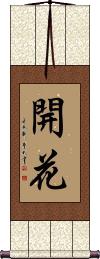Many custom options...
And formats...

開花 in Chinese / Japanese...
Buy an 開花 calligraphy wall scroll here!
Personalize your custom “開花” project by clicking the button next to your favorite “開花” title below...
Opening / Blooming Flowers
開花 literally means opening flowers (a verb).
開花 is also associated with Springtime, the beginning of something, or youth.
If you like flowers and Springtime, this is a great selection for you.
In Korean Hanja, this can be a metaphor for achieving enlightenment or becoming civilized (blooming civilization).
Flourish and Blossom Everywhere
Flowers Bloom and Flowers Fall
花開花落 is a complete proverb that lightly speaks of the cycle of life, or how things come and go in life.
This is used as a metaphor to suggest that youth is a temporary state that in time will pass.
This can also be used to suggest that fortunes can come and go (everything is temporary).
Note: There are two very similar versions of this proverb. The other uses a word that means wither instead of fall.
Flowers Bloom and Flowers Wither
花開花謝 is a complete proverb that lightly speaks of the cycle of life, or how things come and go in life.
This is used as a metaphor to suggest that youth is a temporary state, which in time, will pass.
This proverb can be used to suggest that fortunes can come and go (everything is temporary).
Note: There are two very similar versions of this proverb. The other uses a word that means fall instead of wither.
Not the results for 開花 that you were looking for?
Below are some entries from our dictionary that may match your 開花 search...
| Characters If shown, 2nd row is Simp. Chinese |
Pronunciation Romanization |
Simple Dictionary Definition |
開花 开花 see styles |
kāi huā kai1 hua1 k`ai hua kai hua haruka はるか |
More info & calligraphy: Opening / Blooming Flowers(n,vs,vi) (1) flowering; blooming; blossoming; coming into bloom; (n,vs,vi) (2) flowering (of a civilization, talent, etc.); blossoming; blooming; bearing fruit (of efforts); (female given name) Haruka |
遍地開花 遍地开花 see styles |
biàn dì kāi huā bian4 di4 kai1 hua1 pien ti k`ai hua pien ti kai hua |
More info & calligraphy: Flourish and Blossom Everywhere |
夜開花 夜开花 see styles |
yè kāi huā ye4 kai1 hua1 yeh k`ai hua yeh kai hua |
bottle gourd (i.e. 瓠瓜[hu4 gua1]) |
樂開花 乐开花 see styles |
lè kāi huā le4 kai1 hua1 le k`ai hua le kai hua |
to burst with joy |
開花兒 开花儿 see styles |
kāi huā r kai1 hua1 r5 k`ai hua r kai hua r |
erhua variant of 開花|开花[kai1 hua1] |
開花日 see styles |
kaikabi かいかび |
day of blooming |
開花期 see styles |
kaikaki かいかき |
anthesis; flowering season |
開花衣 开花衣 see styles |
kāi huā yī kai1 hua1 yi1 k`ai hua i kai hua i |
to open a bale of cotton |
嶺上開花 see styles |
rinshankaihou; rinshankaihoo / rinshankaiho; rinshankaihoo リンシャンカイホウ; リンシャンカイホー |
{mahj} (See 嶺上牌) winning hand formed by drawing a replacement tile after declaring a kong (chi:) |
樹上開花 树上开花 see styles |
shù shàng kāi huā shu4 shang4 kai1 hua1 shu shang k`ai hua shu shang kai hua |
to deck the tree with false blossoms; to make something of no value appear valuable (idiom) |
腦袋開花 脑袋开花 see styles |
nǎo dài kāi huā nao3 dai4 kai1 hua1 nao tai k`ai hua nao tai kai hua |
to blow one's brain out |
鐵樹開花 铁树开花 see styles |
tiě shù kāi huā tie3 shu4 kai1 hua1 t`ieh shu k`ai hua tieh shu kai hua |
lit. the iron tree blooms (idiom); a highly improbable or extremely rare occurrence |
開花前線 see styles |
kaikazensen かいかぜんせん |
(cherry) blossom front; flower front |
開花結實 开花结实 see styles |
kāi huā jiē shí kai1 hua1 jie1 shi2 k`ai hua chieh shih kai hua chieh shih |
see 開花結果|开花结果[kai1 hua1 jie1 guo3] |
開花結果 开花结果 see styles |
kāi huā jiē guǒ kai1 hua1 jie1 guo3 k`ai hua chieh kuo kai hua chieh kuo |
lit. to blossom and bear fruit (idiom); fig. to come to fruition; to yield favorable results |
Variations: |
kaikadon; kaikadonburi かいかどん; かいかどんぶり |
{food} bowl of rice topped with beef (or pork) and egg |
The following table may be helpful for those studying Chinese or Japanese...
| Title | Characters | Romaji (Romanized Japanese) | Various forms of Romanized Chinese | |
| Opening Blooming Flowers | 開花 开花 | kai ka / kaika | kāi huā / kai1 hua1 / kai hua / kaihua | k`ai hua / kaihua / kai hua |
| Flourish and Blossom Everywhere | 遍地開花 遍地开花 | biàn dì kāi huā bian4 di4 kai1 hua1 bian di kai hua biandikaihua | pien ti k`ai hua pientikaihua pien ti kai hua |
|
| Flowers Bloom and Flowers Fall | 花開花落 花开花落 | huā kāi huā luò hua1 kai1 hua1 luo4 hua kai hua luo huakaihualuo | hua k`ai hua lo huakaihualo hua kai hua lo |
|
| Flowers Bloom and Flowers Wither | 花開花謝 花开花谢 | huā kāi huā xiè hua1 kai1 hua1 xie4 hua kai hua xie huakaihuaxie | hua k`ai hua hsieh huakaihuahsieh hua kai hua hsieh |
|
| In some entries above you will see that characters have different versions above and below a line. In these cases, the characters above the line are Traditional Chinese, while the ones below are Simplified Chinese. | ||||
Successful Chinese Character and Japanese Kanji calligraphy searches within the last few hours...







